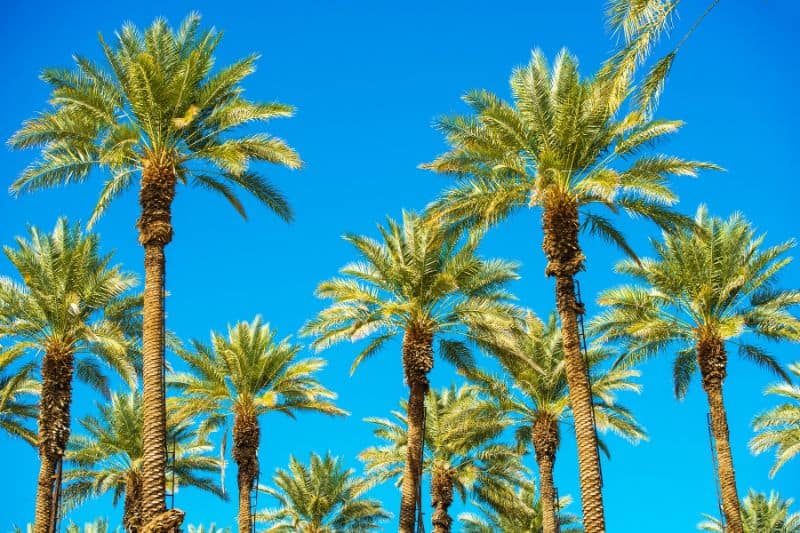Los Angeles is famous for its beaches and roads lined with multiple varieties of palm trees. In fact, these trees are so ubiquitous in that area that they have become synonymous with the Southern Californian city.
But did you know that not all these palm trees are native to California? Most palm trees that you see lined on the streets of California were brought to the State from different parts of the world.
In this post, you will learn all about whether palm trees are native to California and which ones are found in California.
Are Palm Trees Native To California?
Palm trees are not native to California. In fact, most of the palm varieties you see were imported from different regions in the 19th century. The iconic palm trees that most people relate with LA are not native and were introduced at different points in time.
The only species that is native to California is the Washingtonia filifera or the Desert fan palm. This palm is sometimes known as the California fan palm, and is the only species of the tree that is native to the Western United States. It’s too tall and the second tallest of all the palm trees growing in the area, only after the Mexican fan palm.
The palm trees that symbolize California in the present day are native to various warm regions of Asia and Africa. Apart from the California fan palm, almost all the other palm species were imported to California from different parts of the world.
Where Did the Palm Trees in California Come From?
All palm trees except the California palm have been imported to California. The California fan palm, or the Washingtonia filifera came from the Colorado and Mojave deserts. All palms, from the elegant Mexican fan palms to the exuberant Canary Island date palms are imports.
Mexican fan palms have the highest population. These non-native palm trees were imported from Mexico in the 20th century. One of the reasons why palms were brought to California is due to their dense and small root system, making it easy to move and transport them.
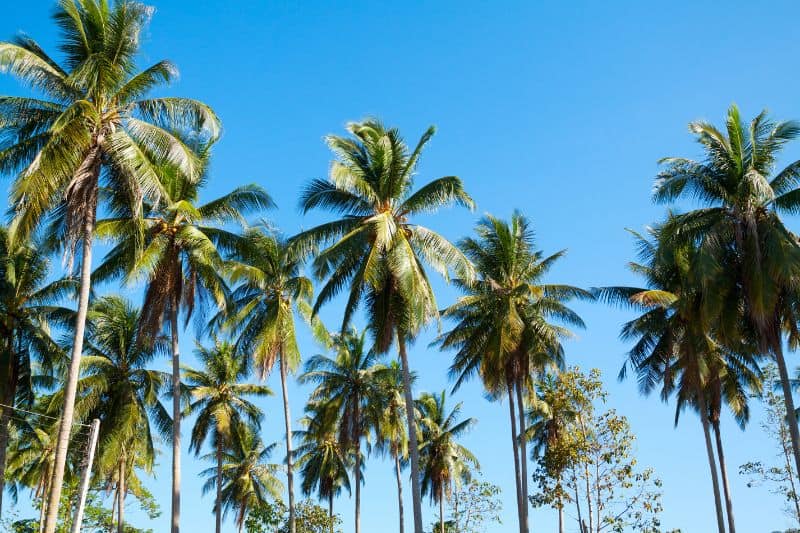
What Kind of Palm Trees are in California?
Apart from the native Washingtonia filifera, palms found in California include:
- Mexican Fan Palm
- Beach Palm
- Miniature Blushing Palm
- Pindo Palm
- Queen Palm
- True Date Palm
- Mediterranean Fan Palm
- Needle Palm
- Sago Palm
- Bamboo Palm
- Paradise Palm
What Kind of Palm Trees Grow in Northern California?
Despite the harsh winters in Northern California, some palm varieties manage to survive the winters. The Coconut palm is one such palm grown in the northernmost part. It can tolerate colder temperatures better than the other tropical palms.
Windmill palm trees are also tolerant of winter temperatures and can adapt to the cool weather conditions of Northern California. Windmill palm is hardy and remains neat with fan-like fronds and little debris.
Christmas fern palms are great for smaller spaces as they can get 10 to 20 feet tall and 5 to 10 feet wide. They are ideal for sidewalks, driveways, and other tight spaces. Other palm trees that are hardy and can grow well in Northern California include the Mexican fan palm, the Parlor palm, the Mediterranean fan palm, and the Jelly palm.
Why are Palm Trees so Tall in California?
Palm trees get so tall in California because they get a similar type of climate to their original habitat. Lots of sunlight helps them to grow high. In general, palms compete in search of more light. Palms like Washingtonia filifera and Mexican fan palm have naturalized to the region.
The temperatures in Southern California are optimal and hardly ever get harsh with no strong winds. The pleasant, tropical weather conditions make it suitable for palm trees to grow comfortably. Plus, unlike the East Coast, California has the lowest number of lightning strikes, reducing the risks of knocking over trees.
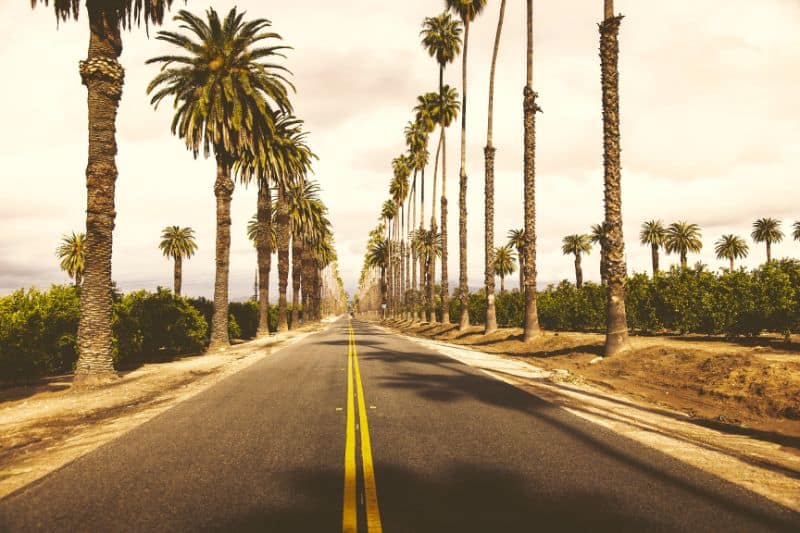
What are the Tall Palm Trees in California Called?
The tall, skinny palms that you see commonly in California are the Mexican fan palms. They can grow to an incredible height of 98 feet with little fronds above and are among the tallest known palms in world history. California fan palms can also get very tall, up to 75 feet, meaning not as tall as the Mexican fan palms.
So yes, apart from the Mexican fan palms, it could be that the tall palms you see are the native California fan palms. The King palm and Queen palm are fast-growing palm trees that can grow tall and have large fronds.
Can Palm Trees Grow in California?
While it was once a shrubland desert, California has become a state known for its palm-lined streets. That’s to say, although the place might have initially been unsuitable for these trees, it has morphed into one of their favorite spots with time.
Today, most palm trees are well-suited to grow in California as they have naturalized over time. Alongside the California fan palms, we also see palms like the Canary Island date palms, Queen palms, and Mexican fan palms.
Palm trees can now easily grow in California due to moderate temperatures, lots of sunlight, and little to no risk of lightning strikes. However, the desert-like soil increases the water needs of the palms in this region. They need abundant watering in the summer.
How Many Species of Palm Trees are in California?
There are lots of palm species in California. 10 of the most common palm plant species that you can find growing in California are the California fan palm, Mexican fan palm, Queen palm, Chinese fan palm, Needle palm, Desert fan palm, Sago palm, Canary Island Date palm, King palm, and Pindo palm.
Southern California does not have a lot of trees, but it receives a lot of sunlight, making it suitable for palm trees to grow.
In fact, besides the 10 listed palm plant species, there are more, but these are the most commonly seen varieties across the warmer regions of California. Most palms prefer bright, warm weather conditions and can tolerate the occasional drought conditions of California.
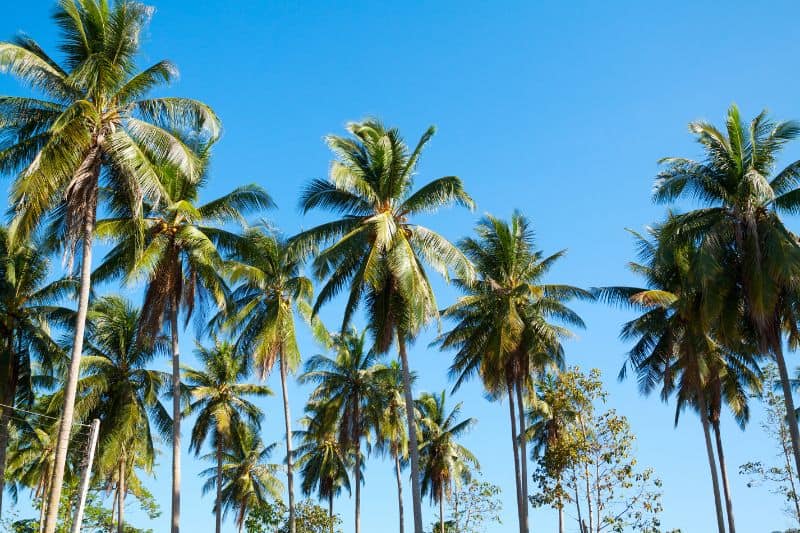
How Old Are Palm Trees in Los Angeles?
Palm trees were introduced in Los Angeles a few hundred years ago. They were brought in the 19th century by Spanish missionaries. And it was sometime in the 1930s that the desert region of Los Angeles was filled with palm trees from Egypt, Mexico, and various other regions.
Palm trees were brought to different regions of California due to their ornamental value and their Biblical associations. In the 20th century, many immigrants came to California, and with them came different palm seeds and plants.
How Much Water Do Palm Trees Need in California?
In areas of California where temperatures go beyond 100 degrees Fahrenheit, you will need to water the palms four to five times a week using drip irrigation or by using a water hose. Most palm trees have high watering and sunlight needs.
Using electronic soil moisture meters is handy to check the soil for moisture and determine how much water the plant needs. Another way is to check the soil by scraping the surface about six inches deep. In general, California’s moderate weather is well-suited for palm tree growth.
Found in tropical and subtropical climates, palm trees need a lot of water to thrive. Maintaining the soil constantly moist helps keep the palms healthy. If the areas receive less water, then they will have increased watering needs.
How Long Does a Palm Plant Live?
A palm tree can live up to many hundred years. Some varieties manage to live up to only 40 years, while others can live for a hundred years or even more. It depends on the variety of the palm plant. But on average, the lifespan of most palm tree species varies from 70 to 100 years.
You can increase their lifespan significantly by using the right fertilizers and providing care. With proper care, you can expect the Mexican fan palms and Date palms to live for up to 100 years, Coconut palms up to 80 years. Areca palms, on the other hand, have the lowest life span of just 40 years.
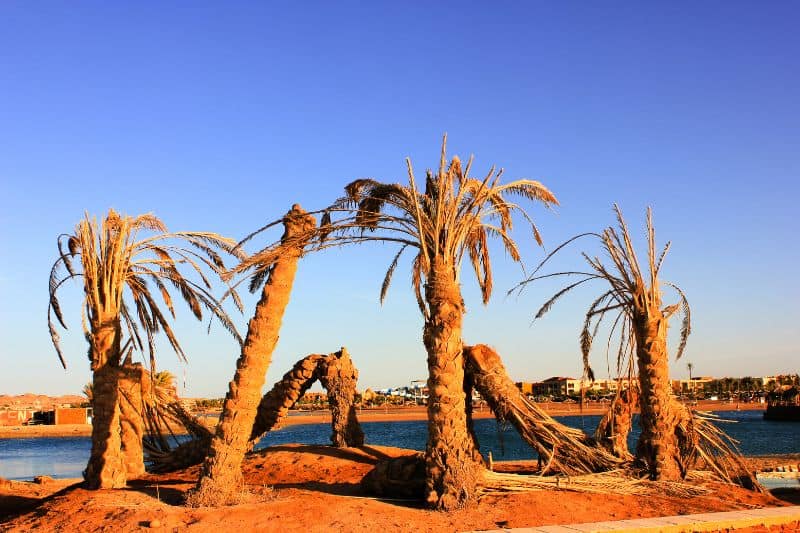
What is Killing Palm Trees in California?
The palms in California are dying due to a beetle infestation. The beetle called the South American Palm weevil and a fungus called Fusarium are responsible for killing the palm trees. A few trees are expected to die due to old age in the coming decades.
It is not known how fast and how many palm trees will die. But they would not be replaced. One of the major reasons behind their death is climate change. It is getting hotter and drier day by day, which makes the bugs thrive more.
While these infestations and hotter-than-usual climates are killing many palm trees, some are dying naturally as well. They have completed their natural lifespan and are approaching the end.
Conclusion
The iconic palm trees symbolize warm and sunny climates and have been synonymous with California. Fan-shaped leaves and waxy trunks give them a sturdy look. Appearing on postcards, t-shirts, and emblems, most palm trees are not native to California.
Even though Los Angeles has become synonymous with tall palm trees, note that none apart from the California fan palm are native to California. They were brought to California from different parts of the world.
